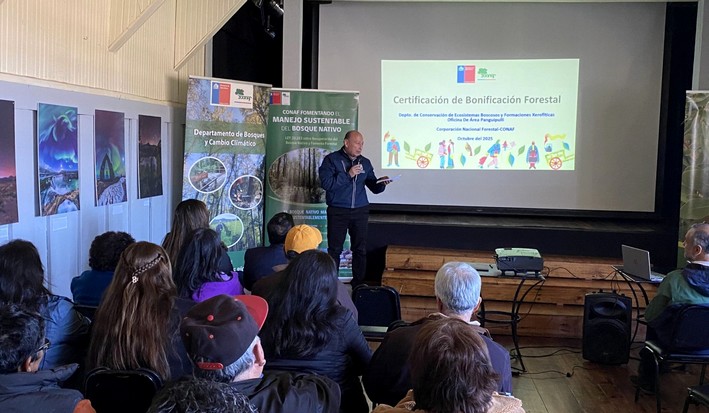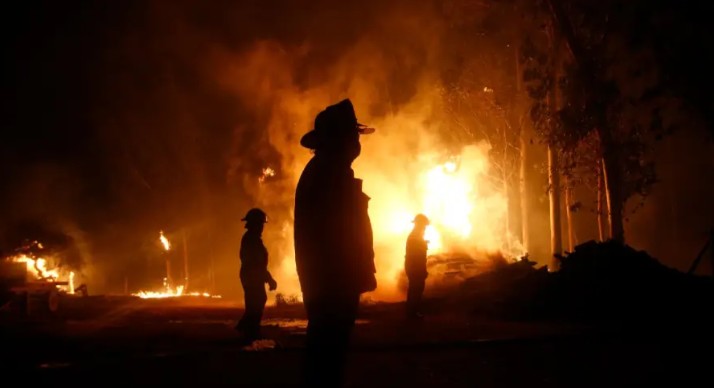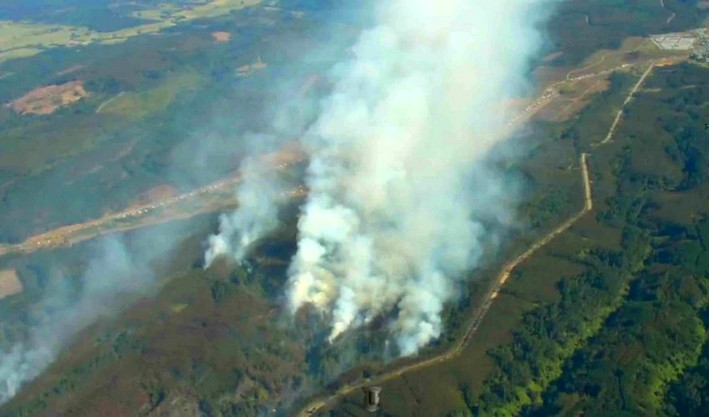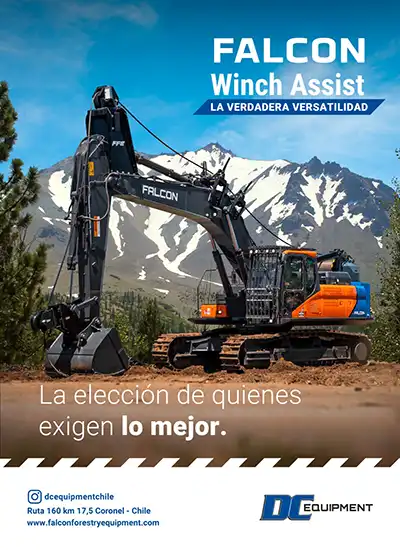"We Must Respond to the Demand for Renewable Products"
Luis Felipe Gazitúa, President of Empresas CMPC, Commercial Engineer from the University of Chile and board member of the Sociedad de Fomento Fabril (Sofofa), spoke with the digital magazine Contratistas Forestales about his vision of the sector where he has spent much of his professional life. As President of CMPC for five years, he closed 2021 with the realization of initiatives such as the construction of the new Duoc UC Nacimiento, involving more families in the "Desafío Agua para Chile" (Water Challenge for Chile), advancing the development of renewable and planet-friendly solutions to achieve net-zero CO2 emissions by 2050, and the creation of Niuform, a new company that will deliver innovative wood-based construction solutions.
What is the importance of the forestry sector today for Chile?
This is a question that could be answered with various figures highlighting the sector's relevance for our country. Over 300,000 jobs, around 2% of GDP, nearly one million hectares of plantations owned by small and medium landowners, and roughly 8% of exports, among the most significant.
However, the deeper answer is more meaningful and forward-looking. Because, just as over 50 years ago this industry emerged as a solution to address Chile's severe soil degradation, it now has the enormous opportunity and responsibility to respond to the growing local and global demand for renewable and environmentally friendly products. Nearly 60% of the country's CO2 emissions are captured by native and productive forests, representing a major contribution to combating climate change and making Chile carbon neutral. Additionally, from these renewable and certified productive forests, we obtain raw materials—wood and fibers—to produce various paper products, paper bags, cardboard boxes, and many others that replace more polluting and non-renewable materials. All this within a broad and deep productive chain involving thousands of small, medium, and large producers, suppliers, contractors, and service providers.
What position do you see for Chile's forestry and timber industry in the world? Is it advancing or regressing?
It is definitely advancing. We are a global example of sustainable production based on renewable and certified plantations. This is confirmed not only by our certifiers but also by sustainability indicators like the Dow Jones Sustainability Index, where our company ranks second globally in the industry. It is also reflected in the evaluation of global investors and consumer preferences.
Does the current forestry framework in Chile promote or incentivize the development of new projects?
If we compare the current situation with the importance previous governments gave to this industry's development—from Eduardo Frei Montalva to Salvador Allende—it seems the country's overall attention to the sector does not match its significance for the contributions I mentioned earlier. The Chilean forestry industry is the result of public and private actors who, since the late 1950s, understood the urgency of addressing soil degradation and the potential it opened for Chile. They thoroughly studied this industry's characteristics and recognized that, particularly for plantations, incentive mechanisms were needed due to long investment and return cycles. This allowed hundreds of small and medium landowners to join this activity while restoring their soils. Today, we do not see the same understanding but rather a series of misconceptions and myths that hinder the serious, informed analysis required for public policy. To be clear, I am not asking for incentives for large companies—they don’t need them. I am thinking, for example, of the thousands of hectares owned by small and medium landowners in Maule who lost their forests in the 2017 fires and are now at the mercy of erosion.
What are the main challenges the forestry sector must address in the short and medium term?
Consistent with what I’ve said, I believe it is crucial for all industry stakeholders to unite and communicate not only the sustainable characteristics of this sector but also the global need for forests that capture carbon while providing renewable raw materials for eco-friendly products. In short, this is a sector of the future.
Now, if you ask me in the very short term, I would say we are facing a dramatic increase in rural fires—most of them intentional—with criminals hindering firefighting efforts, endangering lives, homes, and livelihoods.
Regarding the relationship with Forest Contractors, what importance do you assign to them in the company's development, and what should be the focus to help them grow and contribute as entrepreneurs?
The Chilean forestry industry has always been characterized by a productive ecosystem that includes hundreds of suppliers and contractors of various sizes, who have been fundamental in building the global leadership this sector holds today. To have leading companies in innovation and sustainability, we need a whole chain of contractors who also advance and exemplify innovation and sustainability. In other words, we have world-leading companies because we have forest contractors who are also leaders in their field. The challenge is to continue advancing in this direction, incorporating all possible innovation in areas we must address together, such as electromobility, digitalization, or developing new products based on innovative uses of cellulose or lignin, to name a few examples.
Regarding local communities in the southern macrozone where your company's plantations are located, do you acknowledge past mistakes?
Without avoiding your question, I prefer to emphasize that we want and must be part of the solutions. Of course, good diagnoses are important, but it is easy today to blame the past for all conflicts. What we can say about the present is that we engage with hundreds of communities, most of whom collaborate on joint projects and express a desire to coexist peacefully and harmoniously without abandoning their legitimate aspirations. The presence of minority groups of criminals, drug traffickers, and timber thieves hiding behind these aspirations should not confuse us. These criminals seek to depopulate territories to carry out illegal activities with impunity, even attacking communities themselves, as sadly happens in many areas of our country. Our message to them is dialogue and coexistence.
It has been argued in society that Chile's current forestry model promotes high concentration of plantations, inequality, rural poverty, and native forest destruction. Do you believe this model can continue, or are adjustments needed for social acceptance?
We are always reviewing the plantation model and incorporating international best practices. For example, we are developing a biological corridor strategy to promote biodiversity and protect native wildlife. But the assumptions behind your question lack factual basis. According to official data from Infor and Conaf, Chile has maintained the same 14 million hectares of native forest over the last 50 years, despite being one of the world's largest wood and pulp producers. How? Precisely because renewable and certified forests have prevented native forest destruction. In fact, Infor reports a positive growth-to-harvest balance, with net volume increases mainly (over 70%) from native forests. The claim of plantation concentration is also incorrect—for example, 64% of eucalyptus plantations are owned by SMEs. Lastly, if someone wants to discredit the industry for its local economic impact, they should explain why Constitución, a predominantly forestry municipality, has some of the best socioeconomic indicators in the Maule region. Finally, regarding DL 701, for every peso the state invested in subsidies, private entities contributed 20.
What do you think is the main obstacle preventing a solution to the violence faced by the sector, especially Forest Contractors and their workers in southern regions?
The biggest problem is Chile's extreme centralization, where priorities revolve around Santiago and its surroundings. Weeks ago, over 30 houses were burned in Lake Lanalhue, clearly aiming to depopulate the area. If this had happened in Ñuñoa or Providencia, authorities—current and future—would still be making statements and seeking solutions, and the press would have provided extensive coverage.
How will the company engage with the new political cycle, which incorporates many demands and rights in our country?
CMPC is a century-old company operating in 11 countries, with all investments focused on the long term. This means we have coexisted—and continue to do so—with diverse cultures, ideas, and priorities from authorities in each country. Our priorities lie with employees, communities, customers, consumers, suppliers, contractors, shareholders, and investors. We collaborate, within our role, with authorities to foster public-private partnerships and policies benefiting the broader population.
Are there any investments planned by your company in the southern macrozone regions?
Absolutely. We recently announced a joint venture with local company Corte Lima, creating Niuform, a new firm delivering innovative wood-based construction solutions. We also have a plan to modernize sawmills and new projects in biopackaging.

















